#The Roman Garden Theatre
Explore tagged Tumblr posts
Text
instagram
#porto#portugal#roman temple#roman art#roman empire#roman theatre#roman ruins#mystic ruins#ruins#architecture#archeology#trip#garden#coimbra#Conímbriga#Instagram
5 notes
·
View notes
Text
Ancient Rome through the art of Sir Lawrence Alma-Tadema.
"Alma-Tadema's highly detailed depictions of Roman life and architecture, based on meticulous archaeological research, led Hollywood directors to his paintings as models for their cinematic ancient world, in films such as D. W. Griffith's Intolerance (1916), Ben Hur (1926), and Cleopatra (1934). The design of the Oscar-winning Roman epic Gladiator (2000) took its main inspiration from his paintings, as well as that of the interior of Cair Paravel castle in The Chronicles of Narnia (2005)" Wikipedia (User:JMF)

Tibullus at Delia's (1866) The Roman poet Tibullus is shown reciting to a group of friends in the house of his mistress, Delia.

The Tepidarium (1881) Lounging next to the tepidarium (warm room of the baths) a curvaceous beauty takes her rest. She holds a strigil in her right hand. Oil on panel. included in the 2006 book 1001 Paintings You Must See Before You Die."

Amo te, ama me (1881). Oil on panel

A Roman Emperor AD 41 (1881) Oil on canvas

Spring (1894) Oil on canvas

Caracalla and Geta (1907)

A Favourite Custom (1909) Oil on panel

The Meeting of Antony and Cleopatra (1883) Oil on canvas

An Audience at Agrippa's (1876) Oil on canvas

Caracalla (1902) Oil on panel

The Triumph of Titus: The Flavians (1885) Oil on canvas

Entrance of the theatre (1866) Oil on canvas

The Oleander (1882)

The flower market (1868)

An Eloquent Silence (1890) Oil on panel

The Frigidarium (1890) -Cold water room of the baths- Oil on canvas

Watching and waiting (1897)

The poet Gallus dreaming (1892) Oil on panel

The roses of Heliogabalus (1888) Oil on canvas

A balneatrix (1876) Watercolour painting

A Roman Art Lover (1868) Oil on panel


The Cymbal Player (1872) A Garden Altar (1879

The mirror (1868) Oil on canvas

A Collection of Pictures at the Time of Augustus (1867) Oil

A Sculpture Gallery in Rome at the Time of Agrippa (1867)

Hadrian Visiting a Romano-British Pottery (1884) Oil on canvas

The Baths at Caracalla (1899)

Unconscious Rivals (1893) Oil on panel

Silver Favourites (1903) Oil on wood
285 notes
·
View notes
Text


Ruins of Roman Emperor Nero's 'Theatre' Unearthed in Rome
Archaeologists in Rome think they may have found Nero's theater during a hotel excavation.
Archaeologists in Rome think they may have found the ruins of Nero's theater, a first-century imperial performance space that was widely described in ancient Roman texts but whose whereabouts had remained largely elusive.
The theater is named after Nero Claudius Caesar Augustus Germanicus, who served as Roman emperor from A.D. 54 to his death in 68. Officials are calling the discovery of the theater, located just east of Vatican City, "exceptional." It was likely where Nero rehearsed poetry and put on musical performances, according to ABC News.
More than a millennium after his death, Nero remains one of ancient Rome's most infamous rulers, accused of playing his fiddle while the city burned to the ground during an epic fire. While much has been written about the atrocities and poor governance that occurred under his leadership — he allegedly killed his own mother and two wives and lavishly and indulgently spent Rome's money — he's also remembered as a lover of music and the arts, leading him to offer public performances at his theater, an act that the elite usually didn't partake in. He was particularly fond of playing the cithara, a portable harp-like instrument with seven strings.

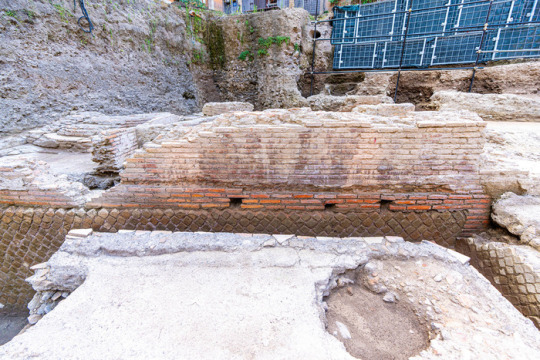

But when the powerful Praetorian Guard, the force in charge of protecting the emperor, withdrew their support of him, he reportedly took his own life, uttering "what an artist dies in me!"
Researchers unearthed a variety of artifacts scattered among the building's ruins. These included seven ornate medieval glass chalices, segments of bone used to carve out rosary beads, clay pots and urns, cooking vessels for baking bread, coins, combs constructed out of bone and numerous pieces of musical instruments. As for the remaining architectural elements of the theater itself, archaeologists unearthed marble columns and plaster decorated in gold leaf, according to ABC News.


"It is a superb dig, one that every archaeologist dreams of," Marzia Di Mento, the site's chief archaeologist, told reporters during a news conference, according to ABC News. "Being able to dig in this built-up, historically rich area is so rare."
The discovery came about as construction crews were working on reconfiguring Palazzo Della Rovere, a medieval palace, into a new luxury hotel, and was found buried beneath the structure's walled garden, according to The Associated Press.
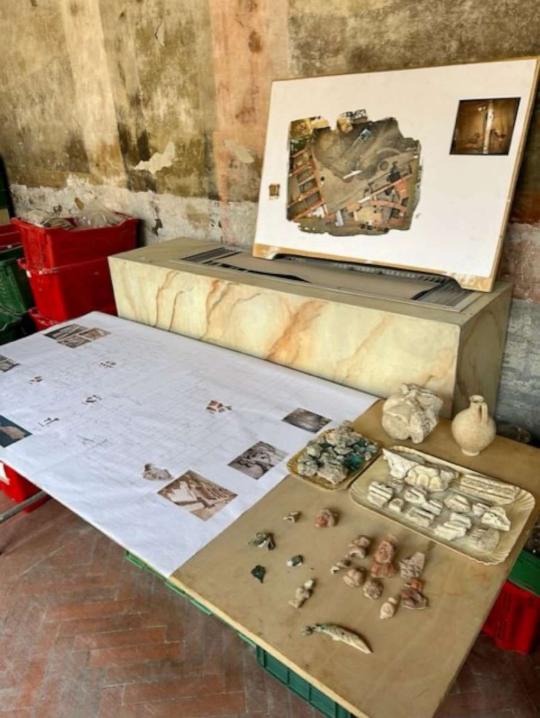


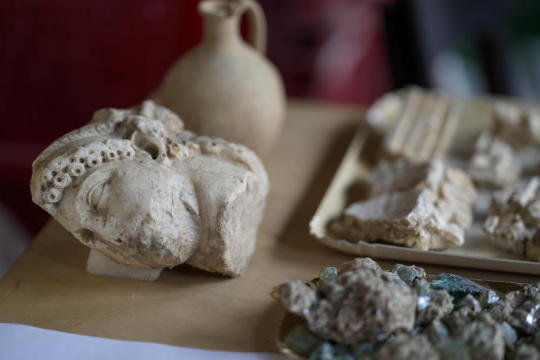


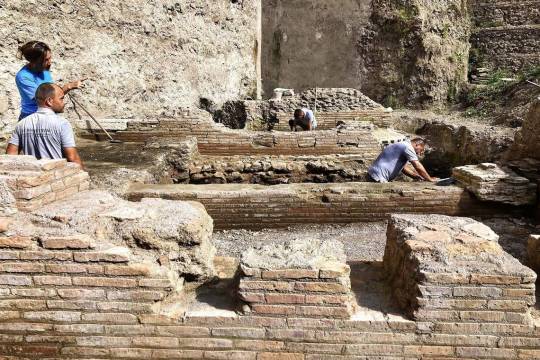
Artifacts from the excavation will be put on display and added to a "city-run public databank to add to the wealth of information gathered over the years on life in Rome throughout the centuries," according to ABC News.
Archaeologists plan to rebury the theater once excavations wrap up.
By Jennifer Nalewicki.


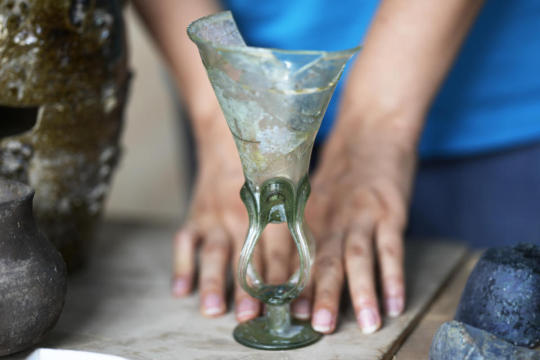

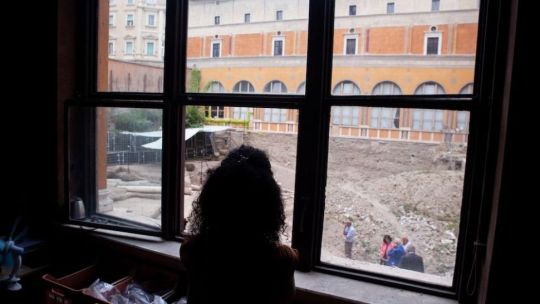
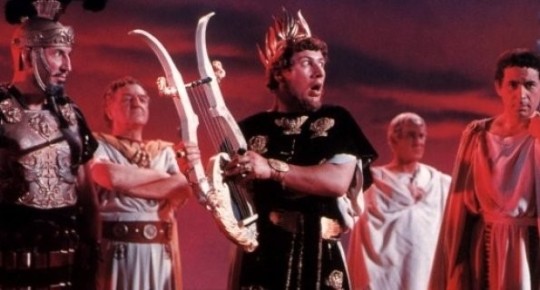

#Emperor Nero#Theatre of Nero#Ruins of Roman Emperor Nero's 'Theatre' Unearthed in Rome#ancient artifacts#archeology#archeolgst#history#history news#ancient history#ancient culture#ancient civilizations#ancient rome#roman history#roman empire#roman emperor#long reads
304 notes
·
View notes
Note
hi!! i’ve recently been feeling a big calling to nature, and i want to research gods/goddesses related to it, but i’m not sure where to start. do you have any tips or know any deities i can research? <3
Hi Anon, I can try my best to help. Since you’re feeling a big calling to nature, you may want to research deities that are associated with the Earth and the natural world. Here are a few deity suggestions to get you started:
• Demeter: Greek goddess of agriculture, harvest, fertility, and motherhood.
• Persephone: Greek goddess of spring, the dead, the Underworld, grain, and nature.
• Freyja: Norse goddess of love, beauty, fertility, sex, war, battle, gold, and sorcery.
• Dionysus: Greek god of wine, drunkenness, parties, wilderness, vegetation, fertility, ritual madness, religious ecstasy, theatre, LGBTQ+ Community, and fruitfulness.
• Gaia: Greek goddess of the Earth.
• Diana: Roman goddess of childbirth, the hunt, fertility, and the moon.
• Pan: Greek god of nature, shepherds, and flocks.
• Artemis: Greek goddess of the hunt, the moon, hunting, and wilderness.
• Cernunnos: Celtic god of the wild, fertility, nature, fruit, grain, the underworld, and wealth, and especially horned animals.
• Danu: Celtic goddess of nature and fertility.
• Ceres: Roman goddess of agriculture, fertility, wheat, and motherly love.
As for tips for working with nature deities, you can start by Developing a reverence and respect for nature and the natural world, as these deities are often closely connected to the natural environment, you can also create a sacred space or altar in a natural setting, such as a garden or forest, to connect with the deity and honour them. Practicing rituals that align with the deity's domain and attributes, like gardening, foraging, or spending time in nature, and researching the deity's myths and stories to gain a better understanding of their values and characteristics. I hope this was some help to you, Blessed be.
#fyp#fypシ#fypシ゚viral#fypage#fyppage#tumblr fyp#witchcraft#witch#witches#deity#deity work#nature#information#helpful#answered
10 notes
·
View notes
Text
day 18 - headcanon
i had too many so no drawing today. instead, i offer a list.
bogan laurance. or, more specifically, bogan meteli. like cmonnn u Cannot tell me that meteli (esp old meteli) is just a standin for small-town new zealand/australia. anyway, they all have aussie/nz accents. laurs is the most obvious bc i think its funny. @shadowqnights @abxolotl this one goes out for you guys <3
on that note, ru'aun's environment is basically new zealand's. especially the sacred forest - it has major nz bush vibes. like.
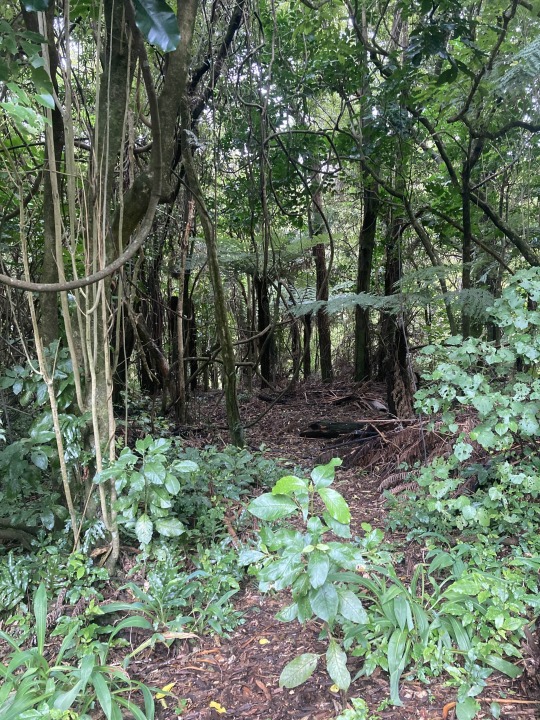
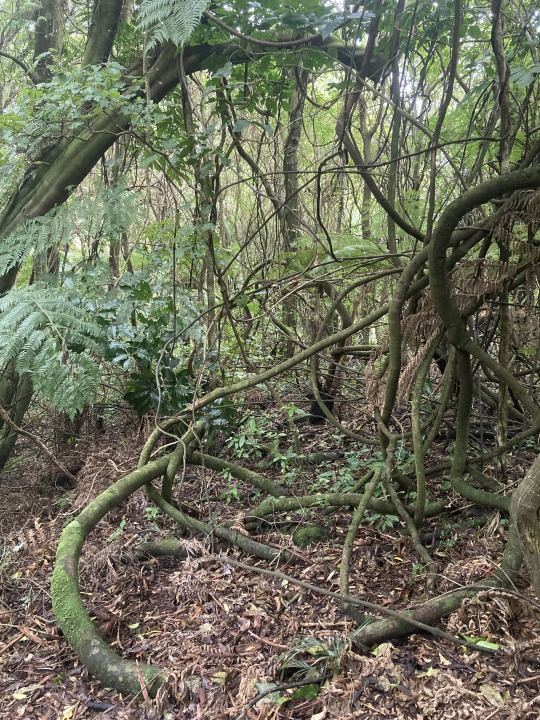


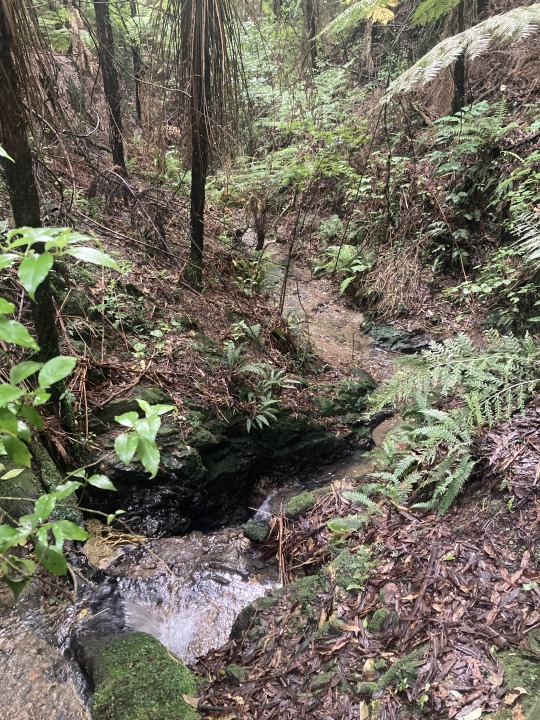
cmon u Cannot tell me that these were taken in the sacred forest of ru'aun.
anyway. travis gets kept up at night by kiwi screaming at each other (seriously. take a listen.)
also, tu'la is inspired by the roman empire. ill probs elaborate on this in the future.
necromancer cadenza! i've spoken abt this before here if u want to see a bit more :3
irene's cathedral/dimension/whatever is less cathedral and more eldritch labyrinth. specifically, i envision it to be a lot like the theatre of domination from honkai impact 3rd.
garroth gardens in his free time! it's how he grows all the flowers for his flower crowns.
meif'wa are werecats; they can 'tuck in' their ears and tails like werewolves can (but it's generally super uncomfortable, no matter the species), and have a sort of hybrid cat-human form that they can also shift into.
melissa is the first ultima - i sort of got into it in this post, but essentially after mel comes back to find falconclaw destroyed and her siblings, aaron and lilly, dead (to the best of her knowledge - aaron is still alive, however), she strikes a deal with a goat-eyed being to bring them back, but because the fine print was specifically worded to fuck her over, her soul ends up getting fused with the wolf that she sacrifices for the ritual and she gets ultima'd.
also, lilly is now aaron and mel's younger sister. she's a ghost.
juror relics! i hate hate Hate how the jurors never get fleshed out in canon, so i gave them a bit more backstory in ashes, ashes. their powers originally came from smaller, less powerful relics that xavier carved off of his own, but after they get lost, they become figureheads for a long time until about 20-25 years prior to the start of ashes, ashes. there's a bit more on this in my day 20 post, pinky promise.
the generals of the shadow lord's army are called "death knells", and although they lead their own units/squadrons/whatever, their primary purpose is to oppose the divine warriors; including the shadow lord (who opposes irene), there are only ever seven death knells at one time. an example of a death knell is gene, who is intended to oppose kul'zak.
zianna is a witch, although, for most of her life, her abilities were passed off as her having prophetic magicks; these 'magicks' are why she was married off to garte, as the ro'meave line wanted to introduce these magicks into the family. unfortunately, the heir, garroth, didn't inherit his mother's abilities, but her two other children, zane/zuwellyn and vylad, did.
nicole is a half elf from her mum's side; her mum is matilda's sister, making her and levin first cousins. this is based on matilda lowkey looking really similar to nicole. idk i just think its fun.
garte sells out o'khasis to tu'la for more power during s2, thus transferring the jury of nine into the control of the king. it's a whole mess, and in the process, he essentially scapegoats zianna by faking his death.
however, this does make zianna lord of o'khasis. we love a girlboss.
the relics have different effects on their wielders; for example, esmund's relic makes its wielders a lot more physically dense, meaning that they'll sink into softer surfaces like sand and mud. xavier's relic turns its wielders hair red.
consequently, zane has red roots. he dyes his hair black (its natural colour) to hide them.
katelyn has the moniker of "the dragon of o'khasis". the phoenix drop gang mostly assumes that it's because she's ruthless on the battlefield... until she decides that the best course of action is to breathe fire at an opponent uncle iroh-style.
katelyn is also Stupidly superstitious. like. she fully believes in the sweater curse and will Refuse to walk under a ladder even if theres no other available path.
mys!nicole gets forever potioned. this has Consequences for the home gang during the events of s5-s6.
speaking of mys!nicole, her and dante are queerplatonic coparents to dmitri. they had him when they were in uni after a brief fling. he's the street's baby.
anyway i think thats abt it. lmk if u have any questions :3
(ps two days until day 20)
#aphtober 2024#aphtober2024#aphblr#aphmau#minecraft diaries#aphverse#mcd rewrite#mcd#mystreet#mystreet rewrite#ashes ashes mcd#we can all be heroes mys
16 notes
·
View notes
Text



December 3rd 1906 saw his Majesty’s Theatre in Aberdeen open soon becoming the city’s leading theatre. His Majesty's Theatre, in Rosemount Viaduct, Aberdeen, was designed by the renowned Theatre Architect Frank Matcham at a cost of £35,000 and opened on the 3rd of December 1906 with a production of the pantomime 'Little Red Riding Hood.'. The Theatre is situated above the Union Terrace Gardens and was built from Kemnay White Granite and has an imposing copper covered dome.The auditorium with its Roman Classical style plasterwork was built on four levels with three curved balconies, and proscenium boxes, it could accommodate an impressive 2,300 people when the Theatre opened, but in 2008 this is a more modest 1,400, still making the biggest theatre in the north east of Scotland. In 1982 the Theatre had a £3 million refurbishment and was reopened on the 17th of September by Prince Charles, having been closed for the previous 23 months. The Theatre was again closed on the 13th March 2004, this time for a redevelopment project costing nearly £8 million and funded by the Aberdeen City Council, The Scottish Arts Council Lottery Fund, and Scottish Enterprise Grampian. The redevelopment included the refurbishment and modernisation of the front of house areas, the building of a new restaurant, coffee shop, and a corporate hospitality suite, a new Green Room and rehearsal room backstage, with improved dressing rooms. The auditorium was also refurbished and the seating re-upholstered. I must admit I have never been in the theatre, while it might be impressive, to me the statue of William Wallace outside is an added bonus. Majesty’s Theatre has their anuall panto on later this month, Jack and the Beanstalk, Greg McHugh aka Gary Tank commander stars with River City's Paul J Corrigan and many others perform a two hour show over two acts. It rus from 12th December to 3rd January.
10 notes
·
View notes
Text

Prior Park Landscape Gardens - Bath - England
Prior Park is a Neo-Palladian house that was designed by John Wood, the Elder, and built in the 1730s and 1740s for Ralph Allen on a hill overlooking Bath, Somerset, England. It has been designated as a Grade I listed building.
The house was built in part to demonstrate the properties of Bath stone as a building material. The design followed work by Andrea Palladio and was influenced by drawings originally made by Colen Campbell for Wanstead House in Essex as well as the twelve sided plan form of the Roman theatre (of which the house's natural setting reminded Wood). The main block had 15 bays and each of the wings 17 bays each. The surrounding parkland had been laid out in 1100 but following the purchase of the land by Allen 11.3 hectares (28 acres) were established as a landscape garden. Features in the garden include a bridge covered by Palladian arches, which is also Grade I listed.
Following Allen's death the estate passed down through his family. In 1828, Bishop Baines bought it for use as a Roman Catholic College. The house was then extended and a chapel and gymnasium built by Henry Goodridge. The house is now used by Prior Park College and the surrounding parkland owned by the National Trust.
17 notes
·
View notes
Text
The Ship of the Day: The Ineffable Husbands
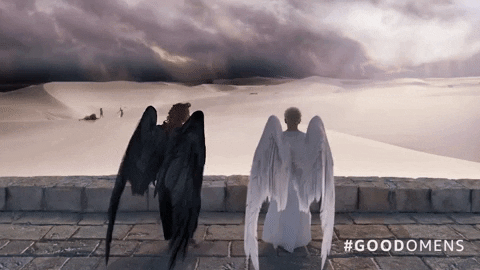
SPOILER WARNING for the Good Omens series, including season 2 :D
Names: Crowley and Aziraphale
Ship name(s): The Ineffable husbands/ Aziraphale
Original Content: Good Omens book (1990) and the Good Omens series (2019 S1, 2023 S2)) and all subsequent world building done by our lord and saviour Neil Gaiman through Tumblr <3
Ship info: Firstly, while the book will be mentioned within this post, it is important to note that i myself have only ever watched the series- as such, if there is information from the books that is failed to be mentioned that you believe should’ve been, this is why; please feel free to add anything you would like in the notes! Secondly, I will be using multiple pronouns for both Aziraphale and Crowley within this post because, as stated by Neil himself in a Tumblr ask, we might as well see them as genderfluid because he does. Similarly, angels (and thus, demons) are defined as sexless beings within the book, who’s “size, and shape, and composition, are simply options”.
So, you may be wondering, “what’s with this bible fanfiction?”, well don’t you worry I will clear that right up!
Good Omens is a novel/book originally written as a collaboration between Terry Pratchett and Neil Gaiman in 1990, exploring the roles of angels, demons and mortals during the apocalypse – Armageddon. This has in recent years been adapted into a series for Amazon Prime Video with the help of Neil our beloved to ensure it stayed true to their vision for this story, especially since the series goes beyond the canon timeline of the book.
In particular, it follows demon Crowley and angel Aziraphale, who, as the only non-mortals residing within the mortal world long term, formed an alliance over the centuries, though this alliance slowly but surely turned into a friendship and then progressed into even more. Now, this might sound like an enemies-to-lovers 400k slow-burn but it’s NOT. You see, Crowley was once an angel prior to his fall, with the fandom theorising that they were a rather high-ranking angel due to his actions and clearance levels depicted within scenes of season 2, so technically they didn’t start off as enemies, nor would I argue that they ever truly became enemies following Crowley becoming a demon. Anyway, the first series follows these two immortal beings as they attempt to prevent the coming of the Antichrist, Adam Young, together. The majority of season one focusses on how Armageddon is coming to fruition and how mortals and immortals alike were attempting to stop it. Despite this, there is still a large focus on Crowley and Aziraphale’s personal relationship throughout time.

Within season 1 episode 3, we take a short break from the ‘current’ canon of stopping Armageddon to explore Crowley and Aziraphale’s relationship and how it grew throughout the centuries using flashbacks for the first portion of the episode, this past history between them before the canon of Armageddon is also explored further in season 2 through multiple extended flashbacks. In the canonical timeline of events, these flashbacks begin from before the beginning of the universe as we know it, with then-angel Crowley creating the universe (“let there be light” and all that) as Aziraphale watched him do so; then jumping to the Garden of Eden, where now-demon Crowley tempts Eve. These flashbacks are sporadic throughout time, gaining in frequency the closer to ‘now’ they get, showing the pairings meetings at: Noah’s Ark, during the testing of Job’s faith (where Crowley first tempts Aziraphale with food), at Jesus’ crucifixion, in a Roman tavern, in Arthurian Britain, and then much more frequently between 1793 in a Paris dungeon and 2019 at Armageddon. All of these flashbacks portray their relationship going from working against each other (in the garden 4004 BC) to working together (the Globe Theatre 1601 AD), though we don’t know the exact date “the arrangement” between the two beings began, it is alluded to within this scene in the Globe Theatre as they discuss the possibility of one of them doing both “the blessing and the tempting” (their respective jobs given to them by heaven and hell) in Edinburgh, as they had done so elsewhere previously, with Aziraphale showing fear for Crowley’s safety within this arrangement, saying “but if hell finds out, they wont just be angry, they’ll destroy you”, but eventually acquiescing, calling heads on the coin toss to decide who goes. These more frequent visits shown leading up to Armageddon show the change from just working together for ease to working together because they enjoyed their time together.
So now we are up to date with their relationship prior to Armageddon, from working together to working against one another all the way up to forming an alliance together and coming to care for one another. So, spoiler alert (I say as if the previous paragraph wasn’t full of spoilers); they stop Armageddon together (yay). Following them preventing Armageddon, hell and heaven attempted to fully discorporate the pair, using hellfire for Aziraphale and a holy water bath (sans rubber duck) for Crowley, the two predicted this move however and temporarily swapped bodies so as to ensure neither came to harm. They then nicely finished off the season with the pair dining in the Ritz, making a toast “to the world” as a nightingale sang in Berkeley Square (in reference to the popular love song published in 1940).
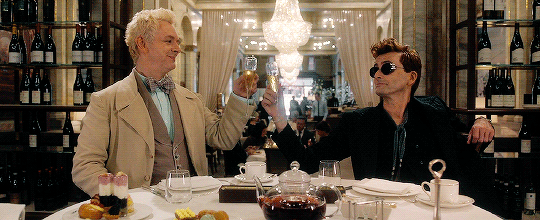
So, all is well and good for the start of season 2, right? WRONG. Archangel Gabriel shows up at Aziraphale’s bookstore having lost all his memories, Crowley and Aziraphale perform a miracle together to hide Gabriel (now going by Jim) that is so strong heaven believes it could only be the will of an archangel, leading to them believing that Gabriel is hiding in Aziraphale’s bookshop. Now, this season evolves around hiding Gabriel and somehow restoring his memories but Aziraphale instead takes it upon himself to focus on trying to set up the owners of two nearby stores, drawing similarities between the two and himself and Crowley. So Aziraphale is trying to set these two up, Crowley is trying to keep Aziraphale safe and heaven and hell alike are both convinced they are hiding Gabriel. This all comes to a head as Gabriel’s memories get restored and it is revealed that he was demoted after refusing to support an attempt at a second Armageddon, conversations are had and offers are made and the elusive Metatron offers Aziraphale Gabriel’s old position, promising to restore Crowley’s status as an angel.
Now for the divorce. Yeah, you read that right, the ineffable divorce. The day I cried, the fandom cried, I think even the official Amazon Prime Twitter *ahem*, sorry, ‘X’ account admin cried. Aziraphale accepts the Metatron’s offer because they believe he and Crowley working together can make a difference, “we can be together, angels, doing good. I need you”. Crowley confesses to Aziraphale, saying how they can do the same as Gabriel and Beelzebub and leave heaven and hell behind to just be them, they disagree on working for heaven and Crowley points out that they can’t hear any nightingales (in reference to the end of season one), “you idiot, we could’ve been us”, before kissing Aziraphale once, finishing off this glorious season with “I forgive you” (A), “Don’t bother”.
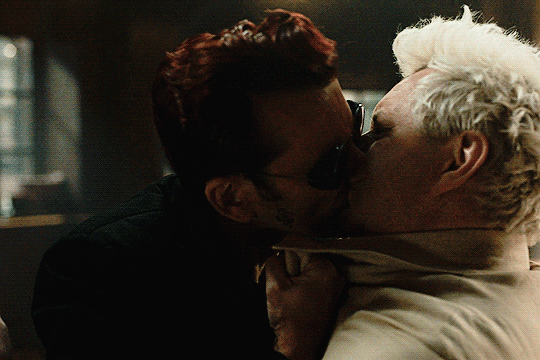
Now, this is where we are left off with their relationship, and while there are a lot more scenes I’ve missed out here which allude to their building romance and many, many posts by Neil Gaiman which explore it further, this has already gotten way too long to include them all.
Type of Ship: Queer
Now, even outside of their relationship, these two are unequivocally queer. As previously stated, they both do not conform to societal stereotypes surrounding gender, with them being angelic beings who simply choose to take on the traditionally more masculine forms we most associate with them, whilst other times choosing more traditionally feminine forms- like Crowley did in scenes of the crucifixion of Jesus, or when they were a nanny. While this isn’t explicitly spoken about within the series (because their gender presentation simply is there, an unquestioned part of them, it’s not a focal point of the plot), co-author and series writer Neil Gaiman has clarified that angels and demons alike do not have gender or sex and do not perceive gender in the same way as humans do.
How, as such, within the ship they are also queer, with the pair not bending to societal norms surrounding gender, sex and relations. And though they do kiss in the final episode of season two, Neil Gaiman has confirmed that their kiss was “about a lot of things but its not to show they’re in love” alluding to the love being shown in other ways as their relationship isn’t inherently sexual- neither is it inherently asexual as he explained “they are an angel and a demon, not as male humans”. This portrays romance and love in away that is inherently queer and different to that of heteronormative ideals as they are not strictly male or female and don’t explore sexuality in the same way as is the norm.
Thank you for reading this! Admin 🦇 out!

#fandom#lgbtq community#ships#gay ships#aziraphale#aziracrow#crowley#crowly x aziraphale#ineffable husbands#ineffable divorce#ineffable idiots
23 notes
·
View notes
Text
@ficwip's 2024 in Review Questions Answered!
This will be long since there're 30 questions, and we all know I have a tendency to talk a lot. Fear not! The first three questions will be above the cut, and the rest under the cut, so's to save your dashes, lmao. (Also, I hate how you can't just type “1.” at the beginning of a line without having it automatically turn into a Numbered List. I'm just now realizing as I type this that I could have done “1:” but I've already done the Roman numerals now, so we're just gonna roll with it I suppose.)
|/|\/|\/|\|
I. How many fics have you worked on since January?
An embarrassing amount, let's call it. Perhaps too many for me to have to remember to be counted.
II. What’s something new that you tried in a fic this year?
Non-linear narratives. Most of the stuff I've written on my ao3 has been fairly linear with clearly defined flashbacks, but I've experimented a bit. I also tried my hand at drabbles again and have successfully done three so far, which I never thought would happen!
III. What piece of media inspired you the most? (This can be the fandom you wrote the most for, the one that spawned the most ideas, the one you thought about the most, etc.)
Unequivocally The Goes Wrong Show and its related plays Peter Pan Goes Wrong and A Christmas Carol Goes Wrong. I have not had creative brainrot this much in so long. Mischief Theatre really came up and fucking walloped me with a hockey stick and it shows.
IV. How many fandoms did you write for this year?
I wrote for a whopping twenty-five different fandoms this year! Very exciting.
[New Girl, The Blooms at Ruyi Pavilion, Derry Girls. Ready or Not (2019), Seraphina by Rachel Hartman, Miraculous Ladybug, Calvin & Hobbes, DC Comics, Pride and Prejudice, The Goes Wrong Show, Peter Pan Goes Wrong, The Witcher, Criminal Minds, Percy Jackson!verse, A Love So Beautiful, Professional Single, Mr. Bean, Wicked Little Letters (2023), Danny Phantom, Over the Garden Wall, Love O2O, Sabrina the Teenage Witch, Red One (2024), and several k-pop and c-pop groups.]
V. What ships captured your heart?
So many, oh my god. But I think the strongest ones have been Chris Bean x Vanessa Wilcock-Wynn-Carroway, Max Bennett x Vanessa, and though I didn't write anything, Ben Affleck x Matt Damon. The tag on my main blog is Full.
VI. What characters captured your heart?
Lydia Bennet, the entire cast of TGWS but esp Chris Bean and Vanessa Wilcock-Wynn-Carroway.
VII. Did you write for any new fandoms or ships this year?
Five new fandoms: The Goes Wrong Show, Peter Pan Goes Wrong, Mr. Bean, Wicked Little Letters (2023), and Red One (2024)
And so many ships, it's embarrassing if I cared.
VIII. What fic meant the most to you to write?
OUGH, what a question. I think maybe the ones I did for Calvin & Hobbes because I've adored the comic for so much of my life? I got to see some of Bill Watterson's original archived work in Columbus, Ohio at the comic book museum in the spring this year, which was fucking incredible.
IX. What fic made you feel the happiest to work on?
Oh, I loved working on the main narrative of my this peace is fragile au, If equal affection cannot be, Let the more loving one be me. I had so much fun creating the cultures of both Kingdoms, and playing around with what the Cornley characters would be like in this situation. I just loved everything about it.
X. What fic was the most satisfying to finish writing?
My Pride and Prejudice modern day AU I wrote for Whumptober 2024, Little Girl, You're in the Middle of the Ride. I really was so invested in what I was writing, and seeing it all come together at the end was so satisfying.
XI. What fic was the most difficult to write?
Oh, hands and above, the first prompt fill for Cornley Christmas Chaos. I can't even remember how many times I restarted the damn fic before throwing in the towel and just deciding to make it a drabble. Which was another added difficulty because I am so bad at keeping my thoughts short. I was successful in the end, though, and the amount of victory I felt was hilarious. (Read it here!)
XII. What fic was the easiest to write?
I think maybe When You Give a Robert A Spell Book… or The Golden Goose. I just remember banging them out in a surprisingly short amount of time.
XIII. What were your shortest and longest fics posted this year?
Longest: If equal affection cannot be, Let the more loving one be me with 11,650 words.
Shortest: Three drabbles this year. A PJO Pipeyna fic entitled a happiness not elusive; the infamous C Cubed Day One prompt fill in the blink of an eye; and a Love O2O fic entitled and i retrocede as if i was swimming, which is a friendship fic between Sīsī and Yìrán.
The difference between the shortest and longest fics are an incredible 11,550 words.
XIV. What were your go-to writing songs?
Whatever was on my Spotify On-Repeat playlist or my playlist “my emo phase pt. ii”. I wasn't super picky with the music this year.
XV. What was the hardest fic to title?
Probably my Ready or Not (2019) pre-canon into canon fic that focuses on Daniel Le Domas thinking about how he got to bleeding out on the floor towards the end of the movie. Nothing I came up with felt right for the longest time, which was annoying. I eventually settled on a dangerous, dangerous game, one that i am definitely losing.
XVI. What’s your favorite title of the year?
Oh, I can't choose just one aldjf;ds. I have a handful that I enjoyed so much.
Younger Family Members Meddling Offers Surprisingly Good Results (not clickbait)
TFW You Find Out You're Marrying Your Brother-in-Law
“Sorry” is a Five-Letter Word (and never does enough)
Hal Jordan Makes a Good Call, Bruce Wayne Found Shocked and in Disbelief
it's hard to speak with a sob in your throat
XVII. Share your favorite opening line.
It was stupid, he knew, to get distracted while one of his hands is inside a piano and the other is hitting keys.
From TFW You Tune Your Strings to the Sound of Her Voice
OR
Róng'ér watches with disbelief as her older sister once again misinterprets Bái-gē’s words and turns his invitation of a date for two to the movies that night into an invitation for their friend group to go out to the movies. Granted, “Would you like to go to the movies tonight?” is a pretty ambiguous statement on its own.
From Younger Family Members Meddling Offers Surprisingly Good Results (not clickbait)
XVIII. Share your favorite ending line.
There’s a streak of blood that almost looked like one of Mom’s arrows on the floor, by his stomach.
From a dangerous, dangerous game, one that i am definitely losing
OR
And if his solicitor couldn’t help… There is hell to pay, and Darce has always been good with money.
From Little Girl, You're in the Middle of the Ride
XIX. Share your favorite piece of dialogue.
“I don’t know,” he said, his tone a touch defensive. “I told him that I was fine. He just had to stick his nose into my business. I was only telling him to buzz off.” Hobbes gave Calvin a dry look. “By calling him a noodle-necked, muffin-brained, straw-for-arms, nosey jerk?” “… Maybe I was a little harsh,” Calvin admitted, magnanimous in demeanor. “You should apologize,” Hobbes said, ignoring Calvin’s faux humility.
From “Sorry” is a Five-Letter Word (and never does enough)
OR
“This just doesn’t make any sense,” Trevor said, “magic doesn’t exist. Not really.” Jonathan gave him an unimpressed stare. “Explain why I’m a metre tall, then.”
From When You Give a Robert a Spell Book…
OR
“I know,” she said, rolling her eyes, “but you’ve only seen him in his uniform. He’s bound to look different in, say, trackies or something.” “If you’ve set me up with a secret chav, I might genuinely push you into the Thames.” “Isn’t that how Ed Gamble says he got his diabetes?” Kitty asked, frowning as she tried to remember what his stand-up routine was. “I’m pretty sure Jacaster or Nish said that,” Lydia corrected, silently willing the path to the ring toss to get longer rather than shorter, as it was currently wont to do. “Never getting over the fact you call him Jacaster,” Kitty giggled, doing a poor job of not looking a little moon-eyed about her celebrity crush. “Never getting over the fact that you audibly squeaked when you saw him in that one Mock the Week episode,” Lydia fired back as only little sisters can. “Oh my god, shut up, I didn’t!” “Right,” Lydia pretended to agree, “and Jimmy Carr doesn’t whiten his teeth.”
From Don't Write Yourself Off Yet
XX. Share your funniest line.
Heresy and Elsie rolled their eyes at the same time. “That’s because you have the unfortunate taste of being into older blond men.” Heresy snarked over her shoulder as the quartet started to ascend the stairs.
From I demand euphoria
OR
“Your coworkers aren’t as bad as I feared,” Calvin said, turning to Hal. “You haven’t met all of them,” Hal said, smirking. “You haven’t met my Dad’s coworkers. Talk about corporate zombies. Yeesh!”
From Hal Jordan Makes a Good Call, Bruce Wayne Found Shocked and in Disbelief
XXI. What’s something that surprised you while you were working on a fic? Did it change the story?
I think for some of them it was that the fic suddenly kept getting longer and longer and I was surprised that I had so much to say. I think that i might've changed it in some of them, giving it greater emotoinal depth, but in others I think it was probably just unecessary descriptions. Well, not unnecessary, but perhaps superfluous in some cases.
XXII. What writing programs did you use? Did you write by hand?
I used the age old, ever important to the writing process tumblr drafts, along with my computer's notes program, and google docs. I think there was one that I started in docs, finished in ao3 then posted it, and then copy-paste it to the original doc, lmao.
XXIII. If you had to choose one, what was THE most satisfying writing moment of your year?
Ohhhh... Maybe how I somehow wrote 11,650 words in one fic? It's my longest oneshot currently, and I didn't realize how much I had been writing.
XXIV. Did you do anything special to celebrate finishing a fic?
Not really. I post about it, and if I can be arsed to do it, I post the link. But for the most part, I just finish it and move on to the next thing.
XXV. How did you recharge between fics?
I got really into watching New York Ballet's videos about The Nutcracker, as well as watching a lot of British comedy stuff.
XXVI. Did you create fanworks other than fic?
I made some neko edits of several characters but nothing much other than that. One of my sideblogs orginally started out as a Danny Phantom x DC Comics crossover-specific blog, now with Over the Garden Wall and Calvin & Hobbes, and I made themed icons and headers for it.
XXVII. How many events did you take part in? (bangs, exchanges, ship weeks, zines, prompt memes, they all count!)
HHAHAHAHAHAHAHAHAHAH so many
Fictober 2024, Whumptober 2024, Cornley Christmas Chaos 2024, 76 Kisses to Valentine's Day 2024-25, Arrowed AUs (a prompt meme list I found a few years ago with little arrows as the bullet points), and Ninette Week 2024.
XXVIII. If this were an awards show, who would you thank?
Definitely my friends and mutuals that I talk to a lot since they got to be witness to my writing process of screaming about how I have no idea what I'm doing. I also owe a lot to @baobeejun who helped "Britpick" my Pride and Prejudice modern day, half-Chinese Bennet daughters AU. Anna has been witness to my nonsense going on five years this spring, and I love her dearly.
XXIX. What’s left on your to-do list for 2024?
I am behind on so many things rn LMAOOOO It's a lot of writing challenges I'd started and not finished, haha. And seeing as I'm posting this on the first day of 2025, I feel like it's very on brand for me.
XXX. What would you like to write next year?
I have the rest of the 76 Kisses left to do, as well as catching up on the other challenges I'd not finished. I do have a prompt meme which I've decided to do this summer entitled "a summer of intimacy", but I'm leaving talking about it more to the early spring!
#heretical texts#heresies#heresy's year in review#if you see this and feel like wanting to answer any of these as well consider yourself tagged! :3c
2 notes
·
View notes
Note
Because someone already asked those questions about your fav anime/manga, can I ask your top 5 favorite western animations (can be movies or series)? Why love them?
Certainly you can dear anon ^7^
So some of my favourite western animations of all time include
1) Tangled

Why do I love it so much? Well it has been my absolute comfort movie since I was like 10 years old and watched this movie in theatres with my older sister. I also highly relate to Rapunzel, both due to her personality and her experiences with Mother Gothel. Also to this day I fully stand by the believe that Flynn/Eugene and Rapunzel’s relationship is the single most romantic and beautifully written Disney couple in this studio’s entire history. Lastly: THE ANIMATION IS GORGEOUS! And I think few people understand just how ground breaking this movie was in terms if 3D animation as back then animating hair, and most importantly that amount of hair that Rapunzel has, was a nightmare to animate in 3D, so the Studio had to essentially come up with an entirely new animation program specifically for the protagonist’s hair to move around in a natural way.
2) Lego Monkie Kid

Created by the Australian Studio Flying Bark Productions, the same Studio behind Rise of the Teenage Mutant Ninja Turtles, this show means EVERYTHING to me. Because one thing rarely talk about on Tumblr: I am OBSESSED with Mythology. Greek Mythology, Roman, Mythology, Yoruba Mythology, Chinese Mythology, Norse Mythology etc. you name it. Like my bookshelf is nothing but Manga, history books and an astronomical amount of mythology and fairytale books. The show follows MK a hyper and optimistic boy as he is chosen to be the Monkey King Sun Wukong’s successor and learning to be a hero. So as you may have gathered this show is not only inspired by chinese mythology but essentially it’s equivalent of what Percy Jackson is to Greek Mythology. What I adore the most about this show are its characters and the GORGEOUS ANIMATION! I swear the fighting animation especially in this cartoon is smoother than butter!
3) The Owl House

Aka "What if Harry Potter was not written by a biggot”. If you’ve seen the pinned post on my blog, you know that Lumity is one of my absolute favourite sapphic ships. But honestly this ship is only the peak of the iceberg for why i adore this show. The beautiful artstyle, Luz’s character arc over the course of the show, EDA SIMPLY EXISTING AND BEING FANTASTIC, the beautiful world building and magic system, Emperor Beloz being an absolute irredeemable asshole in the most entertaining and bone chilling way. Srsly if you can dear Anon, give this show a watch.
4) Infinity Train

An Anthology Series who up until recently you could watch on Max HBO. This show is both delightfully funny and absolutely gut-wrenching and dark. The show essentially follows on a new set of characters each season who all end up getting trapped on a train with an infinite number of cars and they cannot leave the train until they essentially come to terms with and/or face some sort of trauma or other psychological issue they may be struggling with.
And as you may have guessed those themes of working through psychological issues is something that my mentally ill ass highly relates to. Not to mention these are some of the most well handled depictions of mental illnesses in animation i have seen in years. Especially given the show was originally targeted towards children and teenagers. I cannot recommend this show enough.
5) Nimona & Over the Garden Wall

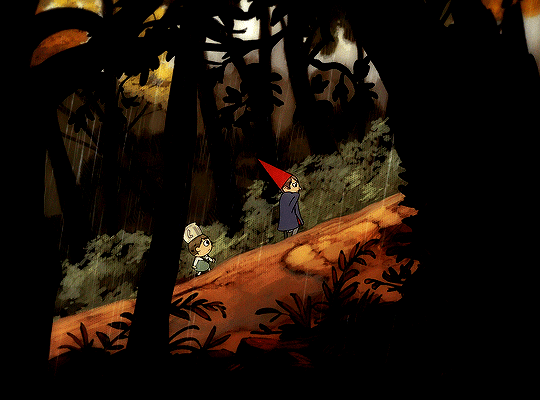
I know you asked for only Top 5 Favourite western Animations but I seriously could not decide which one I prefered so they gotta share the spot. Hope you don’t mind 😊.
Starting with Nimona: I mean what else is there to say about Nimona that has not been said before? Fantastic and unique world building? Check. Absolute comedy gold? Check. Openly Queer characters? Check. Said characters also being absolutely loveable? Check. A heartfelt message for both adults and children? CHECK. Seriously this movie is just gorgeous and on Youtube FOR FREE! Like there is nothing stopping you from watching it right this instant.
Now onto Over the Garden Wall: I come from a country where we don’t typically celebrate Halloween. So due to a lack of direct cultural ties to Halloween I never truly had any super strong interest in Halloween movies and never had the urge around October to bundle up in a blanket and watch those classic Halloween movies and shows, like some of my friends do. The most I did was carve pumpkins with my sister and drink hot cocoa cuz it’s genuinly fun. Until this Mini Series came along. The atmosphere just absolutely perfectly manages to capsulate the feeling of autumn and the eeriness of that season. Far more than any other Halloween Classic in my humble opinion. Also again I’m a huge mythology Nerd and this show is basically Dante’s Inferno for children in very weird way. But yes ever since this show had come out I instantly rewatch it the second the leaves start to fall outside.
#asks open#anon ask#ask game#ask me anything#tangled#disney rapunzel#rapunzel x flynn#rapunzel x eugene#lego monkie kid#monkie kid#owl house#the owl house#lumity#infinity train#ryan infinity train#min gi park#min gi infinity train#nimona#over the garden wall#otgw#disney#queer media#queer animation#fuck jkr#fuck jk rowling
16 notes
·
View notes
Text
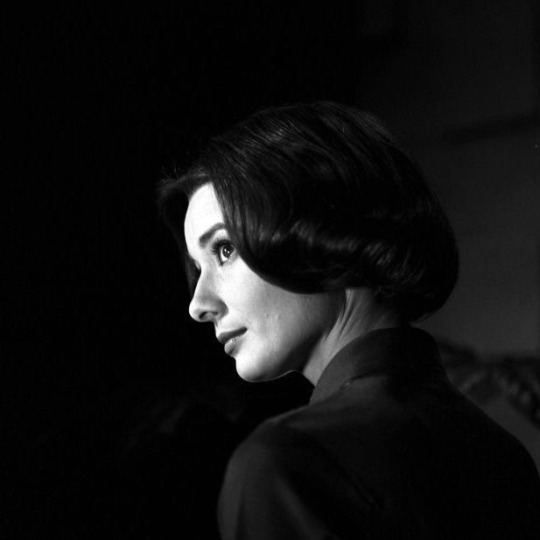
AUDREY HEPBURN
Audrey Kathleen Hepburn (née Ruston; 4 May 1929 – 20 January 1993) was a British actress. Recognized as a film and fashion icon, she was ranked by the American Film Institute as the third-greatest female screen legend from the Classical Hollywood cinema and was inducted into the International Best Dressed Hall of Fame List.
Born into an aristocratic family in Ixelles, Brussels, Hepburn spent parts of her childhood in Belgium, England and the Netherlands. She attended boarding school in Kent, England from 1936 to 1939. With the outbreak of World War II, she returned to the Netherlands. During the war, Hepburn studied ballet at the Arnhem Conservatory and by 1944, she performed ballet to raise money to support the Dutch resistance. Hepburn studied ballet with Sonia Gaskell in Amsterdam beginning in 1945 and with Marie Rambert in London from 1948. She began performing as a chorus girl in West End musical theatre productions and then had minor appearances in several films. Hepburn rose to stardom in the romantic comedy Roman Holiday (1953) alongside Gregory Peck, for which she was the first actress to win an Oscar, a Golden Globe Award, and a BAFTA Award for a single performance. That year, she also won a Tony Award for Best Lead Actress in a Play for her performance in Ondine.
Hepburn went on to star in a number of successful films such as Sabrina (1954), in which Humphrey Bogart and William Holden compete for her affection; Funny Face (1957), a musical in which she sang her own parts; the drama The Nun's Story (1959); the romantic comedy Breakfast at Tiffany's (1961); the thriller-romance Charade (1963), opposite Cary Grant; and the musical My Fair Lady (1964). In 1967, she starred in the thriller Wait Until Dark, receiving Academy Award, Golden Globe and BAFTA nominations. After that, Hepburn only occasionally appeared in films, one being Robin and Marian (1976) with Sean Connery. Her last recorded performances were in the 1990 documentary television series Gardens of the World with Audrey Hepburn, for which she won a Primetime Emmy Award for Outstanding Individual Achievement – Informational Programming. In 1994, Hepburn's contributions to a spoken-word recording titled Audrey Hepburn's Enchanted Tales earned her a posthumous Grammy Award for Best Spoken Word Album for Children. She stands as one of few entertainers who have won Academy, Emmy, Grammy and Tony Awards.
Hepburn won three BAFTA Awards for Best British Actress in a Leading Role. In recognition of her film career, she received BAFTA's Lifetime Achievement Award, the Golden Globe Cecil B. DeMille Award, the Screen Actors Guild Life Achievement Award and the Special Tony Award. Later in life, Hepburn devoted much of her time to UNICEF, to which she had contributed since 1954. Between 1988 and 1992, she worked in some of the poorest communities of Africa, South America and Asia. In December 1992, Hepburn received the US Presidential Medal of Freedom in recognition of her work as a UNICEF Goodwill Ambassador. A month later, she died of appendiceal cancer at her home in Tolochenaz, Vaud, Switzerland at the age of 63
11 notes
·
View notes
Text
Ok damn i have a thought
“In Pursuit Of Excellence” from Children Of Eden really reminds me of Janus, LIKE ITS SUCH A HIM SONG! The song is about Satan tempting Eve in the garden of Eden, and the snake motifs and the jazzy tune just reminds me so much of janus aaahgg
I AM ENVISIONING THE ANIMATIC! Like just imagine an in pursuit of excellence sanders sides animatic where Janus is trying to convince Roman or Logan to become a dark side (I’m leaning towards him convincing roman because its a musical/theatre song) I CAN SEE THE ANIMATIC IN MY HEAD!!!
#listening too it on repeat#im gonna make a storyboard on paper#guys you should listen to it#sanders sides#janus sanders
6 notes
·
View notes
Photo

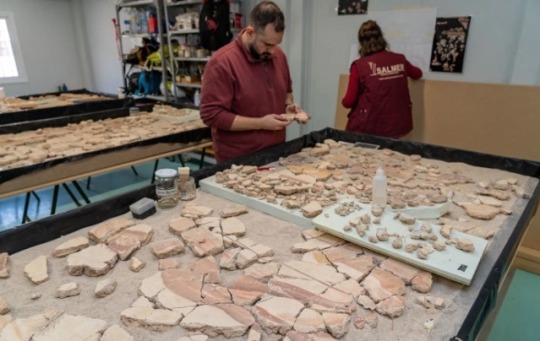

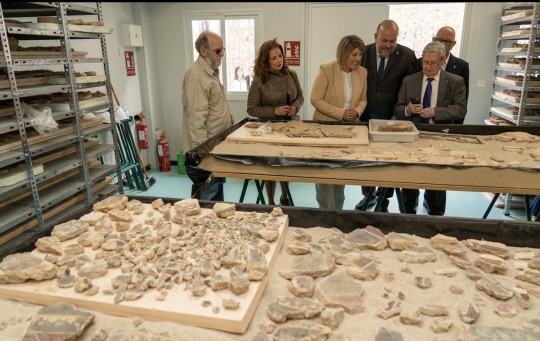
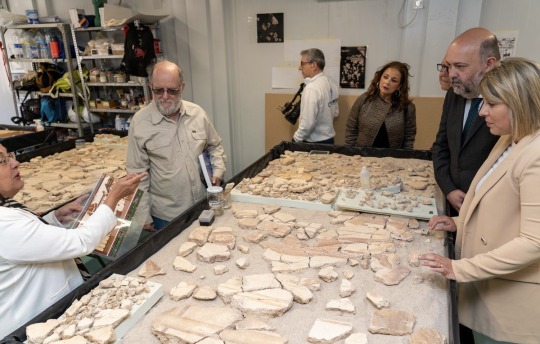
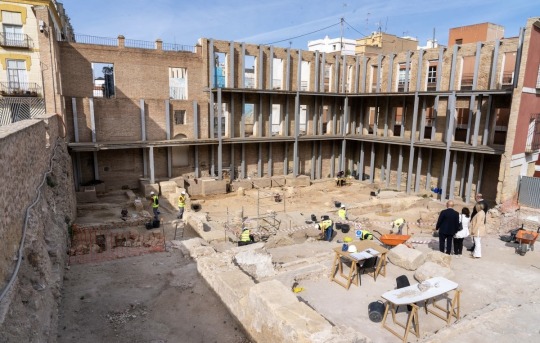
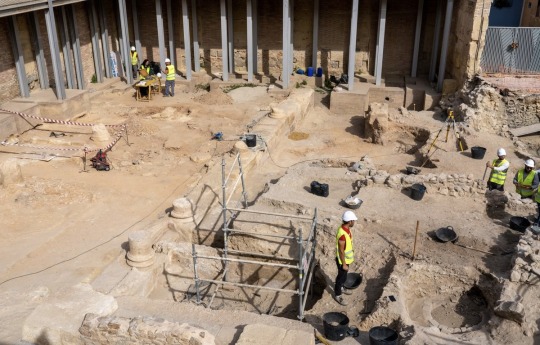

Fragments From a Wall Mural Discovered at a Roman Theater in Spain
ARCHAEOLOGISTS HAVE DISCOVERED FRAGMENTS FROM A WALL PAINTING THAT DECORATED A PORTICO IN CARTAGENA’S ROMAN THEATRE.
Cartagena was founded as a Carthaginian city in 228 BC in south-eastern Iberia, Spain. The city was called Qart Hadasht, meaning “new city”, and served as a staging point for Carthaginian incursions into Spain.
The Roman general, Scipio Africanus, conquered the city in 209 BC, and renamed it as Carthago Nova, emerging as the capital of the Roman province of Carthaginensis.
Between 5 and 1 BC, the Romans constructed a large, monumental theatre, which had a cavea that could hold up to 7,000 spectators for public performances and ceremonies.
The theatre was discovered in 1988 during the construction of the Centro regional de artesanía, resulting in a long-term project of restoration and reconstruction, turning the theatre into an open-air museum.
Recent excavations by a team of archaeologists have discovered over 2,000 fragments from a large mural painting. The painting decorated the walls of a portico (porticus post scaenam) with a double porticoed gallery, revolving around a central room housing a garden at the back of the stage in the western section of the theatre complex.
The discovery adds to 1,500 fragments previously uncovered in 2006, allowing the researchers to continue the process of restoring the painting to its original design with more accuracy.
Although restoration is still in its early stages, depictions of ornate Roman figures are beginning to emerge, in addition to linear artistic features.
Excavations are planned to explore the central garden, where the researchers hope to find evidence of flower beds, piping that fed water to fountains, as well as understand how water was used to maintain the flora in the open space.
#Fragments From a Wall Mural Discovered at a Roman Theater in Spain#Cartagena#Scipio Africanus#ancient artifacts#archeology#archeolgst#history#history news#ancient history#ancient culture#ancient civilizations#roman history#roman empire#roman art
61 notes
·
View notes
Text
Being then in a pleasant frame of mind (from which I infer that poisoning is not always disagreeable in some stages of the process), I resolved to go to the play. It was Covent Garden Theatre that I chose; and there, from the back of a centre box, I saw Julius Caesar and the new Pantomime. To have all those noble Romans alive before me, and walking in and out for my entertainment, instead of being the stern taskmasters they had been at school, was a most novel and delightful effect. But the mingled reality and mystery of the whole show, the influence upon me of the poetry, the lights, the music, the company, the smooth stupendous changes of glittering and brilliant scenery, were so dazzling, and opened up such illimitable regions of delight, that when I came out into the rainy street, at twelve o'clock at night, I felt as if I had come from the clouds, where I had been leading a romantic life for ages, to a bawling, splashing, link-lighted, umbrella-struggling, hackney-coach-jostling, patten-clinking, muddy, miserable world.
David Copperfield by Charles Dickens, "Chapter 19: I Look About Me, and Make a Discovery"
#david copperfield experiences the magic of live theater!#diana rereads david copperfield#i was kicking and screaming when i read this paragraph#god i wish that were me#daisy has a taste for beauty!#this is me inside my deep and wonderful imagination in the year of our lord 2023#i do have to admit i feel like i kinda wanna memorize some of my favorite paragraphs as i reread. i dont know why#i havent PURPOSEFULLY tried to memorize any literature. poetry or prose. since i was a teenager#it was sort of a childish habit of mine. i felt it somehow made me closer to it#not that it doesn't. if thats how it makes you feel.#i guess it also used to be my desire to act/perform. which i dont do at all anymore. shut-in that i am#but ive been so deep in the books and the imagination lately i fancy im practically putting on shows for myself#i live in them now and ill make myself believe them. thats what ill do!#dickens#david copperfield#quotes#victorian literature#shakespeare#julius caesar
9 notes
·
View notes
Text

Roman Gardens at the Theatre of Pompey.
10 notes
·
View notes
Text
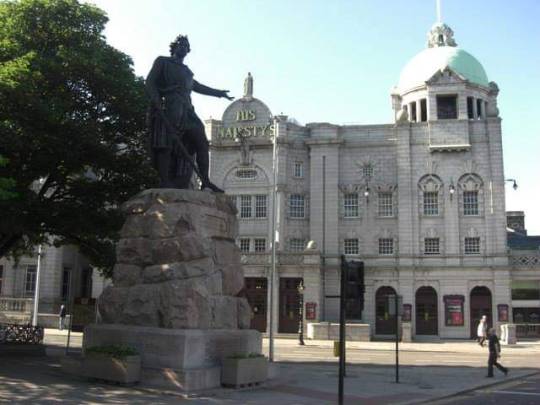
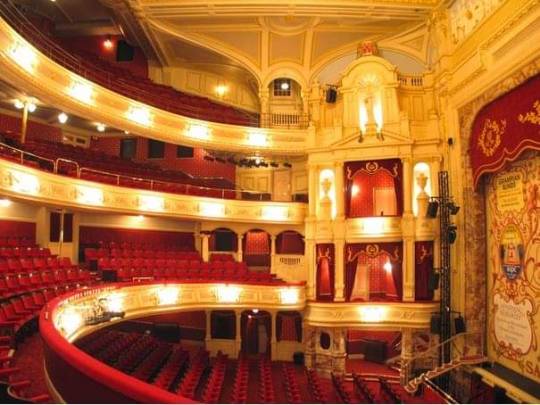
December 3rd 1906 saw his Majesty’s Theatre in Aberdeen open soon becoming the city’s leading theatre.
His Majesty's Theatre, in Rosemount Viaduct, Aberdeen, was designed by the renowned Theatre Architect Frank Matcham at a cost of £35,000 and opened on the 3rd of December 1906 with a production of the pantomime 'Little Red Riding Hood.'.
The Theatre is situated above the Union Terrace Gardens and was built from Kemnay White Granite and has an imposing copper covered dome.The auditorium with its Roman Classical style plasterwork was built on four levels with three curved balconies, and proscenium boxes, it could accommodate an impressive 2,300 people when the Theatre opened, but in 2008 this is a more modest 1,400, still making the biggest theatre in the north east of Scotland.
In 1982 the Theatre had a £3 million refurbishment and was reopened on the 17th of September by Prince Charles, having been closed for the previous 23 months.
The Theatre was again closed on the 13th March 2004, this time for a redevelopment project costing nearly £8 million and funded by the Aberdeen City Council, The Scottish Arts Council Lottery Fund, and Scottish Enterprise Grampian.
The redevelopment included the refurbishment and modernisation of the front of house areas, the building of a new restaurant, coffee shop, and a corporate hospitality suite, a new Green Room and rehearsal room backstage, with improved dressing rooms. The auditorium was also refurbished and the seating re-upholstered.
I must admit I have never been in the theatre, while it might be impressive, to me the statue of William Wallace outside is an added bonus.
44 notes
·
View notes